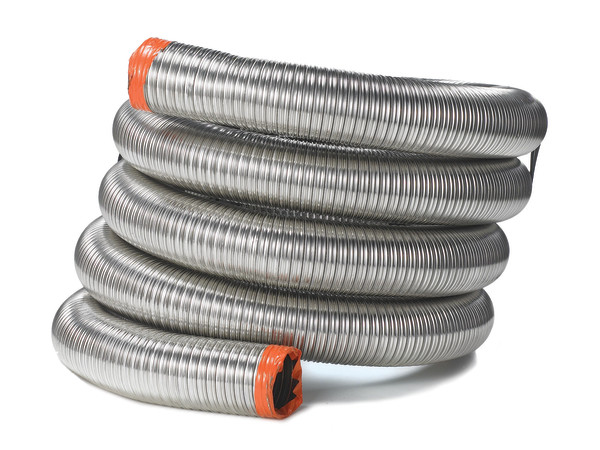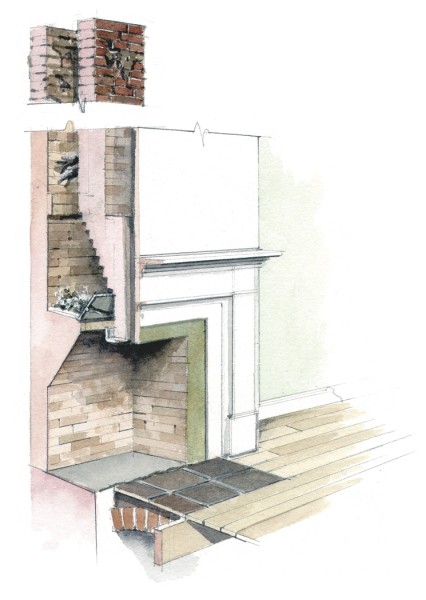
A chimney that serves a working fireplace is the most visible component of a complex combustion system that supplies heat and beauty to the hearth. A well-built chimney draws well, quickly venting the smoke and gases created by the fireplace. After decades of use, however, chimneys are susceptible to deterioration that may not only rob them of their function, but also make them dangerous to use. Delayed maintenance usually means costly repairs.
Note, too, that many old brick and tile hearths are laid directly over wood subflooring or framing, bringing combustible material dangerously close to the firebox. Have it inspected; a noncombustible, reinforced concrete slab can be poured in place over new framing, if necessary.
LINER IT
CLAY
Unlined chimney flues aren’t safe, no matter how new they are. Since flues in older houses are subject to invisible cracks, obstructions, and other damage that can lead to fires, it’s imperative to install a liner if the fireplace is used frequently. There are three types of liner: clay, metal, and cast in place.
Many older homes are lined with square or rounded 2′-long clay tiles that drop into place inside the flue and are sealed together. After a lifespan of 50 years or so, they eventually crack and break, leaving the chimney vulnerable to fire. They are also difficult to remove. Better options include:

METAL
A flexible or rigid stainless steel liner kit installed by a chimney pro is the solution for most existing wood- or gas-burning chimneys. Aluminum is a less expensive alternative for a lower-heat gas-burning fireplace. Include high-temperature insulation as part of the installation.
CAST IN PLACE
Suitable for all fuels, these lightweight cement-like systems line the chimney with a smooth, seamless, insulated passageway of high-temperature mortar. More expensive to install than a metal liner, this type counts on mortar to fill in voids and seal them. A side benefit: The masonry liner tends to strengthen the chimney.
Chimney Top
Missing or cracked brick and crumbling mortar are signs of damage from trapped moisture, common in old chimneys with lime mortar. If the part of the chimney that passes through attic space is deteriorating, it may mean the attic is poorly ventilated. Efflorescence—salty white deposits, often near the top of the chimney—is a warning that the bricks are absorbing moisture.
To prevent downdrafts and ensure good draw, the top of the chimney should be at least three feet above the highest point where it comes through the roof. The chimney should also be at least two feet higher than any portion of the roof within a 10-foot radius. You can increase effective height by installing a chimney pot.
INSPECTION

• Examine the exterior chimney for cracks, missing mortar, and settling around the foundation. If you see evidence of deterioration or moisture, contact a masonry professional for a thorough inspection.
• Look for loose or inadequate flashing around the perimeter of the chimney at the roofline. If it’s damaged or missing altogether, install new flashing that’s set into the mortar joints at least 1½” deep.
• From the basement or crawl space, check whether the hearth and its projecting apron rest on a masonry or stone foundation. If the hearth is supported by wood framing or a wood subfloor, you’ll need a new reinforced concrete support before the fireplace is safe to use.
• Check to see that the firebox is lined with refractory (or fire) brick and fireclay mortar. A chimney sweep can tell you if the fireplace meets this standard. A steel or cast-iron firebox distorted by exposure to heat should be replaced.
• Make sure there are no obstructions in the throat, the slot-like opening just above the firebox, or on the smoke shelf just behind it. (You’ll need to stick your head into the fireplace and look up to see them.)
• If the damper isn’t working properly or is missing altogether, replace it. Dampers can be spot-bedded just above the throat, or at the top of the chimney.
• Inspect the flue for creosote, a highly flammable black, sooty substance that can build up on the walls. If it’s thicker than a dime, it’s time for a cleaning.
• Have the chimney professionally checked and cleaned once a year by a chimney sweep or masonry professional certified by the Chimney Safety Institute of America (csia.org).







